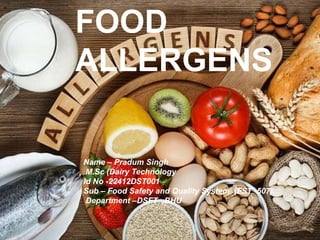
FOOD ALLERGENS.pptx
- 1. Name – Pradum Singh M.Sc (Dairy Technology Id No -22412DST001 Sub – Food Safety and Quality System (FST -507) Department –DSFT ,BHU FOOD ALLERGENS
- 2. An allergen is any normally harmless substance that causes an immediate allergic reaction in a susceptible person. Food allergens are almost always proteins although other food constituents, such as certain additives, are known to have allergenic (allergy-causing) properties. The most common example of food allegrens are - Milk,Egg,Peanut,Wheat,Fish,Soyabeans, Wheat,Treenuts etc
- 3. Food Allergen Labeling and Consumer Protection Act (FALCPA) 2004. This law identified eight foods as major food allergens: On April 23, 2021, the Food Allergy Safety, Treatment, Education, and Research (FASTER) Act was signed into law, declaring sesame as the 9th major food allergen
- 4. Food allergie is caused by food allergens. Food allergies occur when the body's immune system reacts to certain proteins in food. Food allergic reactions vary in severity from mild symptoms involving hives and lip swelling to severe, life-threatening symptoms, often called anaphylaxis, that may involve fatal respiratory problems and shock. While promising prevention and therapeutic strategies are being developed, food allergies currently cannot be cured.
- 6. symptoms of a food allergy almost always develop a few seconds or minutes after eating the food. Tingling or itching in the mouth. Itchy red rash (urticarial) – in some cases, the skin can turn red and itchy, but without a raised rash Swelling of the face, mouth (angioedema), throat or other areas of the body. Difficulty swallowing. Wheezing or shortness of breath. Feeling dizzy and lightheaded. Feeling sick (nausea) or vomiting. Abdominal pain or diarrhoea. Hay fever-like symptoms, such as sneezing or itchy
- 7. The symptoms of a severe allergic) reaction (anaphylaxis) can be sudden and get worse very quickly. Increased breathing difficulties – such as wheezing and a cough. A sudden and intense feeling of anxiety and fear A rapid heartbeat (tachycardia). A sharp and sudden drop in your blood pressure, which can make you feel lightheaded and confused. Unconsciousness.
- 8. Generally, many major food allergens are major food proteins. food allergens are very stable molecules that resist the effects of food processing, cooking, and digestive enzymes in the gut. Food allergens are polyvalent molecules with at least two or more IgE antibody binding sites. most food allergens are between 10 and 70 kDa and are primarily glycoproteins with acid isoelectric points. High-protein foods are more allergenic as compared to low protein foods.
- 10. Different sources of food allergens contain several allergenic molecules (components); these can be produced as recombinant proteins or purified from natural sources. These allergens can be classified into IgE - reactive components (green), which are poor activators of inflammatory cells and therefore induce little or no clinical reactions. Components that induce mild or mainly local symptoms (yellow); and components that often area associated with severe and systemic allergic reactions (red). Micro array technology can be used to determine reactivity profiles of patients.
- 12. Multiplex allergen systems can be used to identify disease-relevant food allergens in populations. (A) Based on the mapping of antigen epitopes recognized by patients’ IgE and Tcells, 4 molecular approaches are being developed for prophylaxis and treatment. These are as follows: recombinant wild-type allergens, carrier-bound B-cell epitome–containing peptides (which do not react with IgE, have reduced allergen- specific epitopes recognized by T cells, also and induce allergen-specific IgG.
- 13. Recombinant hypo allergens (which have reduced reactivity with IgE and fewer epitopes that interact with T cells, and induce allergen-specific IgG), and peptide epitopes that interact with T cells (but do not react with IgE . Allergen-specific treatment can be prophylactic(prenatal or early postnatal) or be given after sensitization . Active vaccination, passive immunization with allergen- specific antibodies, and tolerance induction are options.
- 16. Exclusive breastfeeding is recommended for the first 4– 6 months of life, which prevents the development of allergies. Breastfeeding transfers protective SIgA to the child, which may prevent allergic sensitization, and avoids early exposure to potential food allergens. If breast feeding is not possible hypoallergenic formulas with documented preventive effects are recommended for high-risk children. There is no clear evidence that administration of prebiotics or lipopolysaccharides can prevent the development of allergies.
- 17. Three approaches, based on modified allergens, have been developed to make allergy vaccine more safe, effective, and convenient. These allow for selective targeting of different facets of the allergic immune response. They include synthetic allergen-derived peptides that contain allergen-specific T-cell epitopes without IgE reactivity. Because of their small size, peptide vaccine scan induce T-cell tolerance without allergen-specific IgG responses. These approaches are in immunotherapy trials for patients with respiratory allergies.
- 18. While most symptoms from food allergies are mild and limited to skin or digestive discomfort, some may progress to a severe, life-threatening allergic reaction. To avoid any reaction, it is important for consumers to be aware of, and avoid, the foods that induce the allergic reaction. There is still no such medicines in the market to cure the food allergy . Infant feeding is best till date.
- 19. Muraro A, Werfel T, Hoffmann-Sommergruber K, et al.EAACI food allergy and anaphylaxis guidelines: diagnosis and management of food allergy. Allergy 2014;69:1008–1025.100.Nermes M, Salminen S, Isolauri E. Is there a role Gellerstedt M, Bengtsson U, Niggemann B. Methodologicalissues in the diagnostic work-up of food allergy: areal challenge. J Investig Allergol Clin Immunol 2007 . Hagel AF, deRossi T, Zopf Y, et al. Mast cell tryptaselevels in gut mucosa in patients with gastrointestinal symptoms caused by food allergy. Int Arch Allergy Immunol 2013; Taylor, S.L. & S.B. Lehrer. 1996. Principles and characteristics of food allergens. Crit. Rev. Food Sci. Nutr. 36(S): S91– S118. Taylor, S.L., R.F. Lemanski, R.K. Bush & W.W. Busse. 1987. Food allergens: structure and immunologic properties. Ann. Allergy 59: 93– 9